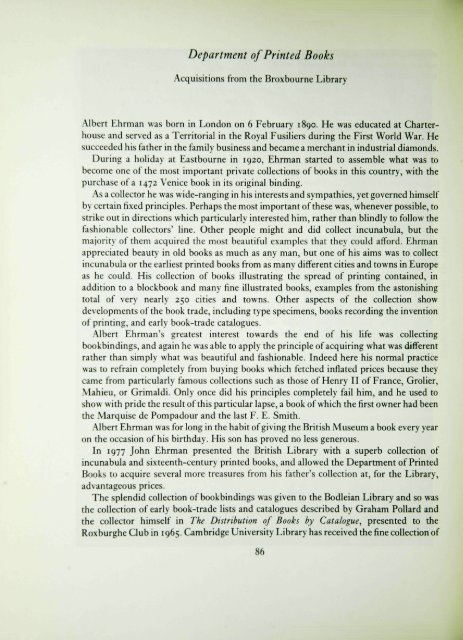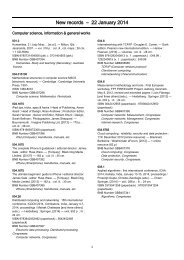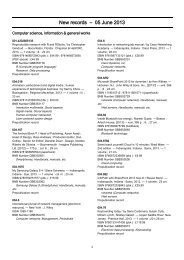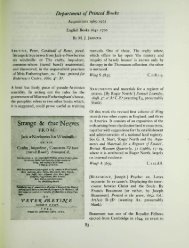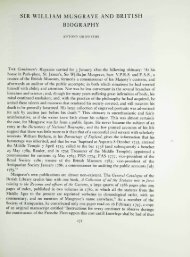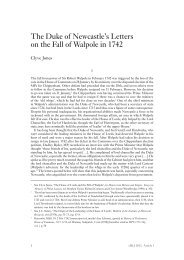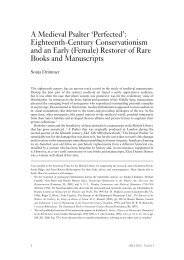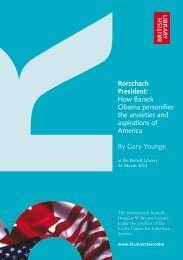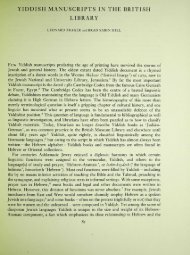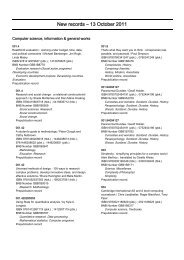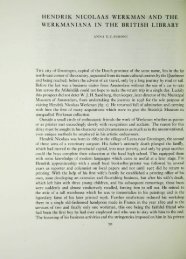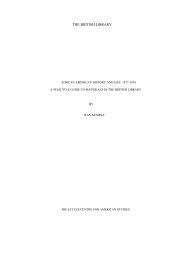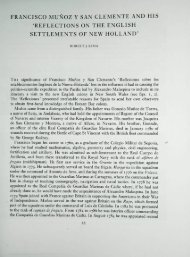Department of Printed Books: Acquisitions from the ... - British Library
Department of Printed Books: Acquisitions from the ... - British Library
Department of Printed Books: Acquisitions from the ... - British Library
Create successful ePaper yourself
Turn your PDF publications into a flip-book with our unique Google optimized e-Paper software.
<strong>Department</strong> <strong>of</strong> <strong>Printed</strong> <strong>Books</strong><br />
<strong>Acquisitions</strong> <strong>from</strong> <strong>the</strong> Broxbourne <strong>Library</strong><br />
Albert Ehrman was born in London on 6 February 1890. He was educated at Charterhouse<br />
and served as a Territorial in <strong>the</strong> Royal Fusiliers during <strong>the</strong> First World War. He<br />
succeeded his fa<strong>the</strong>r in <strong>the</strong> family business and became a merchant in industrial diamonds.<br />
During a holiday at Eastbourne in 1920, Ehrman started to assemble what was to<br />
become one <strong>of</strong> <strong>the</strong> most important private collections <strong>of</strong> books in this country, with <strong>the</strong><br />
purchase <strong>of</strong> a 1472 Venice book in its original binding.<br />
As a collector he was wide-ranging in his interests and sympathies, yet governed himself<br />
by certain fixed principles. Perhaps <strong>the</strong> most important <strong>of</strong> <strong>the</strong>se was, whenever possible, to<br />
strike out in directions which particularly interested him, ra<strong>the</strong>r than blindly to follow <strong>the</strong><br />
fashionable collectors' line. O<strong>the</strong>r people might and did collect incunabula, but <strong>the</strong><br />
majority <strong>of</strong> <strong>the</strong>m acquired <strong>the</strong> most beautiful examples that <strong>the</strong>y could afford. Ehrman<br />
appreciated beauty in old books as much as any man, but one <strong>of</strong> his aims was to collect<br />
incunabula or <strong>the</strong> earliest printed books <strong>from</strong> as many different cities and towns in Europe<br />
as he could. His collection <strong>of</strong> books illustrating <strong>the</strong> spread <strong>of</strong> printing contained, in<br />
addition to a blockbook and many fine illustrated books, examples <strong>from</strong> <strong>the</strong> astonishing<br />
total <strong>of</strong> very nearly 250 cities and towns. O<strong>the</strong>r aspects <strong>of</strong> <strong>the</strong> collection show<br />
developments <strong>of</strong> <strong>the</strong> book trade, including type specimens, books recording <strong>the</strong> invention<br />
<strong>of</strong> printing, and early book-trade catalogues.<br />
Albert Ehrman's greatest interest towards <strong>the</strong> end <strong>of</strong> his life was collecting<br />
bookbindings, and again he was able to apply <strong>the</strong> principle <strong>of</strong> acquiring what was different<br />
ra<strong>the</strong>r than simply what was beautiful and fashionable. Indeed here his normal practice<br />
was to refrain completely <strong>from</strong> buying books which fetched inflated prices because <strong>the</strong>y<br />
came <strong>from</strong> particularly famous collections such as those <strong>of</strong> Henry II <strong>of</strong> France, Grolier,<br />
Mahieu, or Grimaldi. Only once did his principles completely fail him, and he used to<br />
show with pride <strong>the</strong> result <strong>of</strong> this particular lapse, a book <strong>of</strong> which <strong>the</strong> first owner had been<br />
<strong>the</strong> Marquise de Pompadour and <strong>the</strong> last F. E. Smith.<br />
Albert Ehrman was for long in <strong>the</strong> habit <strong>of</strong> giving <strong>the</strong> <strong>British</strong> Museum a book every year<br />
on <strong>the</strong> occasion <strong>of</strong> his birthday. His son has proved no less generous.<br />
In 1977 John Ehrman presented <strong>the</strong> <strong>British</strong> <strong>Library</strong> with a superb collection <strong>of</strong><br />
incunabula and sixteenth-century printed books, and allowed <strong>the</strong> <strong>Department</strong> <strong>of</strong> <strong>Printed</strong><br />
<strong>Books</strong> to acquire several more treasures <strong>from</strong> his fa<strong>the</strong>r's collection at, for <strong>the</strong> <strong>Library</strong>,<br />
advantageous prices.<br />
The splendid collection <strong>of</strong> bookbindings was given to <strong>the</strong> Bodleian <strong>Library</strong> and so was<br />
<strong>the</strong> collection <strong>of</strong> early book-trade lists and catalogues described by Graham Pollard and<br />
<strong>the</strong> collector himself in The Distribution <strong>of</strong> <strong>Books</strong> by Catalogue, presented to <strong>the</strong><br />
Roxburghe Club in 1965. Cambridge University <strong>Library</strong> has received <strong>the</strong> fine collection <strong>of</strong><br />
86
early type specimens and related material, and various o<strong>the</strong>r libraries have pr<strong>of</strong>ited by Mr.<br />
Ehrman's generosity.<br />
The rest <strong>of</strong> <strong>the</strong> Broxbourne <strong>Library</strong>, so named after <strong>the</strong> little town <strong>of</strong> Broxbourne in<br />
Hertfordshire where <strong>the</strong> Ehrmans lived when <strong>the</strong>y started to collect books, was sold at<br />
So<strong>the</strong>by's in two sales on 14, 15 November 1977 and 8, 9 May 1978. Several important<br />
purchases were made by <strong>the</strong> <strong>British</strong> <strong>Library</strong>.<br />
In what follows. Miss Jean Archibald, Dr. Lotte Hellinga, Mr. D. L. Paisey, Dr. D. E.<br />
Rhodes, and Miss A. E. C. Simoni have described <strong>the</strong> books <strong>from</strong> <strong>the</strong> Broxbourne Gift<br />
(marked with an asterisk) as well as <strong>the</strong> most notable purchases made before and at <strong>the</strong> two<br />
sales.<br />
INCUNABULA<br />
The incunabula are arranged in ^.'VfC-order. The copies are identified by <strong>the</strong> number in Albert<br />
Ehrman's own record <strong>of</strong> his collection. These consist <strong>of</strong> a figure preceded by AE.R. The figures<br />
correspond to <strong>the</strong> ledger kept by <strong>the</strong> collector showing date and source <strong>of</strong> acquisition. This ledger is<br />
now in <strong>the</strong> Bodleian <strong>Library</strong>.<br />
GERMANY, POLAND, and<br />
cerning elementary instruction in Latin, were<br />
CZECHOSLOVAKIA<br />
considered as one until <strong>the</strong>y were recently<br />
dissected. It was <strong>the</strong>n established that <strong>the</strong><br />
REGULE CONGRUITATUM, constructiones et<br />
volume was made up <strong>of</strong> copies <strong>of</strong> three distinct<br />
regimina cum locali ordinatione constructibilium.<br />
Nuremberg: Friedrich Creussner, 1493.<br />
editions, two <strong>of</strong> which were unrecorded.<br />
4°: 12 leaves, [ab^.]<br />
AE.R.375. IA.7700.<br />
Bound before IA.7699 and IA.7700.<br />
Hain 13833.<br />
AE.R.375. IA.7698.<br />
DoNATUS MINOR. Nuremberg: Friedrich<br />
Creussner, 1493. 4*^: 16 leaves, [ab^.] Leaves i,<br />
8 wanting.<br />
Unrecorded edition similar to Cesamtkatalog<br />
8911. Bound between IA.7698 and IA.7700.<br />
AE-R-375- IA.7699.<br />
REGULA DOMINUS quae pars. Nuremberg:<br />
Friedrich Creussner, [c. 1493.] 4°: 4 leaves, [a**.]<br />
Bound after IA.7698 and IA.7699.<br />
These three Nuremberg books, all con-<br />
NEGLIGENTIE et defectus in missa contingentes.<br />
Erfurt: [Printer <strong>of</strong> Hundorn, i.e.<br />
Heulericus and Marx Ayrer], 1494. 4":<br />
4 leaves, [a"".]<br />
The subject matter <strong>of</strong> this little treatise destined<br />
for <strong>of</strong>ficiants at Mass is graphically depicted in<br />
<strong>the</strong> title-woodcut.<br />
AE.R.1806. IA.12636.<br />
VoCABULARius optimus Gemma vocabulorum<br />
dictus. Magdeburg: Mauritius Brandis,<br />
21 August 1497. 4"^: 240 leaves, <strong>the</strong> last blank.<br />
a-z 7 A-Q^.<br />
Moritz Brandis was quick <strong>of</strong>f <strong>the</strong> mark to<br />
reprint an edition <strong>of</strong> <strong>the</strong> Cemma vocabulorum in
I<br />
JEglismtit tt itfmtia<br />
in f[<br />
IA. 12636<br />
f
Low German in December 1495, only ten<br />
months after this version had appeared in<br />
Cologne for <strong>the</strong> first time in February <strong>of</strong> <strong>the</strong><br />
same year. His success is obvious <strong>from</strong> <strong>the</strong><br />
present edition, a reprint <strong>of</strong> his first within two<br />
years. The earlier editions are not represented<br />
in <strong>the</strong> <strong>British</strong> <strong>Library</strong>.<br />
Borchling-Claussen 285.<br />
AE.R.-^ IA.10958.<br />
MiSSALE iuxta rubricam ecclesiae Misnensis.<br />
Freiberg-in-Sachsen: Conrad Kachel<strong>of</strong>en,<br />
9 November 1495. fol.: 269 leaves. # \*f<br />
While <strong>the</strong> present Missal was being printed<br />
an outbreak <strong>of</strong> <strong>the</strong> plague forced <strong>the</strong> wellestablished<br />
Leipzig printer Conrad Kachel<strong>of</strong>en<br />
to move his press a respectable distance out <strong>of</strong><br />
<strong>the</strong> city to <strong>the</strong> smaller town <strong>of</strong> Freiberg. He<br />
completed here only <strong>the</strong> present Missal which<br />
was commissioned by <strong>the</strong> Bishop <strong>of</strong> Meissen for<br />
<strong>the</strong> use <strong>of</strong> his diocese.<br />
Hain-Copinger 11327.<br />
AE.R.1070. IC.14503.<br />
*TuRRECREMATA, Joannes de. Expositio<br />
Psalterii. Cracow: [Printer <strong>of</strong> Turrecremata,<br />
i.e. Caspar Hochfeder? not after 1476.] fol.:<br />
151 leaves, [a-c^^ f«; g'^^ h'—^' i-o'" p'-.J<br />
The above collation applies to <strong>the</strong> copy <strong>of</strong> this<br />
book bought by <strong>the</strong> <strong>British</strong> Museum in May<br />
1931 (IB.51308). In <strong>the</strong> present copy quire h<br />
collates simply h^"^, and it contains <strong>the</strong>refore 150<br />
leaves. This is, however, far <strong>from</strong> being <strong>the</strong> only<br />
difference between <strong>the</strong> copies. For about half<br />
<strong>the</strong> book <strong>the</strong> two copies have different typesetting.<br />
The variant typesetting has a curious distribution,<br />
which shows that it was done virtually<br />
simultaneously, as work shared between<br />
two compositors. Comparison <strong>of</strong> <strong>the</strong> two copies<br />
may <strong>the</strong>refore throw light on <strong>the</strong> practice <strong>of</strong><br />
parallel typesetting <strong>of</strong> which o<strong>the</strong>r instances are<br />
known in <strong>the</strong> fifteenth century.<br />
Bound toge<strong>the</strong>r witb three sixteenth-century<br />
books in a sixteenth-century quarter binding <strong>of</strong><br />
white pigskin over wooden boards, tooled in<br />
blind and black with <strong>the</strong> arms <strong>of</strong> Hcsscn in <strong>the</strong><br />
centre.<br />
Hain *<br />
AE.R.1437-<br />
IB.51309.<br />
TwiNGER, Jacob, von Konigsh<strong>of</strong>en. Martymiany.<br />
[Translated into Czech by Benes z<br />
H<strong>of</strong>ovic] Prague: [Printer <strong>of</strong> <strong>the</strong> 14SH Prague<br />
Bible], 1488. fol.: 102 leaves, <strong>the</strong> first and last<br />
blank. a-i»o k^^<br />
This acquisition <strong>from</strong> <strong>the</strong> Broxbourne <strong>Library</strong>,<br />
comprising <strong>the</strong> first purchase <strong>of</strong> a Czech incunable<br />
by <strong>the</strong> <strong>British</strong> Museum (<strong>Library</strong>) since<br />
1885, has already been noted in <strong>the</strong> <strong>British</strong><br />
<strong>Library</strong> Journal, v, no. i (Spring, 1979),<br />
pp. 102-3.<br />
AE.R.751. IB.51406.<br />
ITALY<br />
BuLLA suspensionis Indulgentiarum propter<br />
tuturum Annum Iubilei. [Rome: Eucharnts<br />
Silber, after 12 April 1498.] 4": 2 leaves.<br />
The only copies <strong>of</strong> this papal bull <strong>of</strong> Alexander<br />
VT recorded by <strong>the</strong>CJT arcat Einsiedeln,<br />
Stiftsbiblio<strong>the</strong>k, and Seville, Hiblioteca Colombina.<br />
Cesamtkatalog 899.<br />
AE.R.1277. IA.19030.<br />
{a) HiSTORiA et descriptio urbis Romae.<br />
Rome: Johannes Besicken and Sigismundus<br />
Mayr, 16 June 1494. 8": 56 leaves, a-g^. Wants<br />
eleven leaves.<br />
IA.19372.<br />
{b) MIR A BILIA Romae urbis. [Rome: Besicken<br />
and Mayr, 1494 ?] 8": 8 leaves. [a».]<br />
Hain 11186. IA.19373.
g tcoLg,<br />
pnus N bjrb.nrmox Chnrn.>nf anriqu, rhc<br />
I g c n fcuporc ^rtoniti ^dm.Htt fuiir.<br />
fi I<br />
q p -f re c5par«uj Tumm. rr<br />
lcge.ircm uotuprjtc:K unliwrc affinj. CG<br />
d«nn. cufcuncj, aur mcdiocnrcr cru;<br />
A n pC(r^r.P^rccoro;riuc.^<br />
i t ^<br />
rum diccrc non pudct.nrc pigCt.Lc^c modo<br />
nic;fli fjrcbcrc non mcnrum^fcd fi fcmet Ic<br />
RCs^rurHin, rclcgcs: K c«cris confulc-ut<br />
niccmanrK Icgant.Bcne'u«Ic.<br />
FRAH.RHOL.TARVISANVS<br />
GERAR. OE L!SA SCRTPTORI •<br />
MEI COPIAM FECIT<br />
VT IPSE CAETERIS<br />
MAI ORE M COriAM<br />
FAC£RET.<br />
.TARVISII.<br />
• M.CCCC.LXXI. NOVEMB<br />
(c) DIVI s I o N E s decem nationum. [Rome:<br />
Besicken and Mayr, 1494 f\ 8": 4 leaves, [a**.]<br />
Cesamtkatalog 8572.<br />
f/am 6308.<br />
AE.R.1299. IA.19374.<br />
These three small anonymous works were<br />
printed over and over again m Rome: for<br />
example, <strong>the</strong> CIV records twenty-two editions<br />
<strong>of</strong> (
no copy <strong>of</strong> <strong>the</strong> present work recorded in Italy or<br />
America.<br />
Hain-Copinger 15748.<br />
Proctor 6970.<br />
AE.R.1550.<br />
IA.31096.<br />
HoMODEis, Signorolus de. Solemnes repetitiones.<br />
'Senis' [Pavia: Francesco Cirardengo],<br />
i6 February 1497. fol: 18 leaves, <strong>the</strong> last<br />
blank. ab''c2;ab''.<br />
The whole question <strong>of</strong> false Sienese imprints<br />
used in incunabula printed at Milan and Pavia<br />
has been discussed by D. E. Rhodes in<br />
'More Light on Fifteenth-Century Piracies<br />
in Nor<strong>the</strong>rn Italy', Cutenberg Juhrbuch (1958),<br />
pp. 96-8. O<strong>the</strong>r copies are at Genoa University,<br />
Milan Biblioteca Nazionale, and Trento Biblioteca<br />
Comunale.<br />
/G/4805.<br />
AE.R. 1782. IC.3i4i8b.<br />
CANARO, Antonius de. De executione instrumentorum.<br />
Pescia: [Printer <strong>of</strong> Canaro] for<br />
Bastianus and Raphael, sons <strong>of</strong> Jacobus<br />
Cerardusde Orlandis <strong>of</strong> Pescia, 15 March 1491.<br />
fol: 8 leaves, a^.<br />
No o<strong>the</strong>r locations in<br />
recorded by <strong>the</strong> CW.<br />
Cesamtkatalog 5963.<br />
AE.R.1275.<br />
<strong>the</strong> <strong>British</strong> Isles are<br />
IC.35038.<br />
*PsALTERiUM Romanum. Castano Primo:<br />
Johannes Antonius de Cornate, 12 January<br />
i486. 4**: 164 leaves, a-u^ x^.<br />
Apparently <strong>the</strong> only surviving copy <strong>of</strong> <strong>the</strong> only<br />
book printed in <strong>the</strong> fifteenth century at Castano<br />
Primo, about twent>- miles west <strong>of</strong> Milan. The<br />
book was fully described in The <strong>Library</strong> (Fifth<br />
series, viii, no. 2, June 1953, pp. 128-9) by<br />
V. Scholderer, who suggested that <strong>the</strong> printer<br />
may possibly be identical with Joannes<br />
Antonius de Honate, who worked in Milan<br />
<strong>from</strong> 1477 to 1489. The volume is imperfect.<br />
ufqs ad Domimcam prmuV q<br />
riinL*: t i<br />
iqj ad<br />
adiicntiim<br />
Q Hgnificcmcdom<br />
GtoruUauitfpinrus mcuoioe<br />
<strong>of</strong>alutarimcoQuifl rcfpcpt bumiU<br />
tafctnancillcfuctcca'cmmcrbccbea<br />
tammcdtcnitocegcncrationco Qui<br />
fl fecit mibi magna nui potcno eft ct fa<br />
(tumnomcnciuoUt mifcncordia ex"<br />
flprogcmcinprogcmem:timcntibuec<br />
um 7 cat potcntiam m bracbio fuc:<br />
oifpcrfuiuBbosmcntecordiefui Oe<br />
poiuup<strong>of</strong>cntcoocfcdet'ietaltauitbu<br />
milce H furiente© iplcmt bometct Di<br />
uu^epimifitianco Hufcepit ifrt puc<br />
rufuu:fcordat''mici'ue Hic locul'e<br />
adpfcfni<strong>of</strong>labrabii: feimci^i fccuU<br />
^cnn la ad u<strong>of</strong>paiaiUcliauit. po cniq<br />
Otlcri^nifraudictDi'ieiuocc oro<br />
memfeOuiaicliauitaureruarii<br />
tioicb''Tfnrmocat>oOir?ococftifido<br />
Ucioc -z doLorc iuci t nomc Dm iuaaui<br />
since <strong>the</strong> place <strong>of</strong> sheets 3 and 4 has been taken<br />
by duplicates <strong>of</strong> sheets fi and f2.<br />
AE.R.- IA.35160.<br />
ANTONINUS, Florentinus. Confessionale:<br />
Defecerunt. [Milan? c. 1473.] 4"; 86 leaves.<br />
[a-d«e•'f-i«kM«m^]<br />
The only o<strong>the</strong>r book printed in <strong>the</strong> same types is<br />
Bartholomaeus de Sancto Concordio, Summa<br />
de castbus conscientiae, 21 October 1473 {CW<br />
3450), which B.MC vii, 1123 (IB.36835) tentatively<br />
ascribed to Milan. Evidence which has<br />
accumulated since <strong>the</strong>n, mainly derived <strong>from</strong><br />
<strong>the</strong> early provenance <strong>of</strong> o<strong>the</strong>r copies, considerably<br />
streng<strong>the</strong>ns this attribution, making Milan<br />
virtually certain as <strong>the</strong> place <strong>of</strong> printing; but <strong>the</strong><br />
printer's identity will probably never be known.<br />
Cesamtkatalog 2102.<br />
AE.R.1283. IA.36837.<br />
FRANCE and SWITZERLAND<br />
CoNSOBRiNUS, Joannes. De iusticia commutatiua.<br />
[Edited by Jacobus Lupi.] Paris:
Cuiilo Mercator {Cuy Marchant), 14 November<br />
i4()(). H": 48 leaves, a f^<br />
The author, Joao Sobrinho, was a Portuguese<br />
Carmelite wbo may have studied in Oxford as<br />
well as in Bologna. Three editions <strong>of</strong> his tract<br />
De iustitta commutativu were printed in <strong>the</strong><br />
fifteenth century, all in Paris. The <strong>British</strong><br />
<strong>Library</strong> already has <strong>the</strong> first (IA.39336, printed<br />
in 1483). This is <strong>the</strong> third.<br />
Cesamtkatalog 7439.<br />
AE.R.658.<br />
IA.39671.<br />
*GRANOLLOACHS, Bernardus de. Lunarium.<br />
[Lyons: Pierre Mareschal and Barnabe Chaussard,<br />
not before 1499.] 8"*: 28 leaves. A-C^ D".<br />
Bernardus de Granollachs, master <strong>of</strong> arts and<br />
medicine at Barcelona, was a very popular<br />
author <strong>of</strong> lunar almanacs calculated for <strong>the</strong><br />
years 1500-50. He was widely printed in Italy<br />
and France, but <strong>the</strong> present edition appears to<br />
exist in this single copy only.<br />
AE.R.951. IA.41994.<br />
DEGUILLEVILLE, Guillaumc de. El pelegrino<br />
dela vida humana. [Translated <strong>from</strong> French<br />
into Spanish b\ \ icente de Mav'uelo.]<br />
Toulouse: Henricus Aleman [Heinrich Mayer],<br />
1490. fol: 104 leaves, a n**. With many woodcuts.<br />
The only Spanish version <strong>of</strong> <strong>the</strong> first <strong>of</strong> <strong>the</strong><br />
three 'Pilgrimages <strong>of</strong> <strong>the</strong> human soul' by <strong>the</strong><br />
fourteenth-century Cisterciati monk Guilclmus<br />
de Deguilla-Villa or Guilleville.<br />
Hain-Copinger 7848.<br />
C<strong>of</strong>fG 639.<br />
AE.R.893. IB.42453-<br />
DE HAQUEVILLE [Christian name unknown].<br />
Sermones dominicales. [Edited by Johannes<br />
Qu'inunus.][.ingers: Jean de la Tour?c. 1480.]<br />
4": 160 leaves, <strong>the</strong> first and last presumably<br />
blank, a-v^.<br />
The only known copy <strong>of</strong> this edition. The<br />
92<br />
variations <strong>of</strong> type make <strong>the</strong> identification <strong>of</strong> <strong>the</strong><br />
printer somewhat uncertain, although <strong>the</strong>re is<br />
no doubt as to Angers being <strong>the</strong> correct place <strong>of</strong><br />
printing, especially as this copy has a provenance<br />
note <strong>of</strong> <strong>the</strong> Recollect Fa<strong>the</strong>rs <strong>of</strong> <strong>the</strong><br />
'Hospitium Duretalli', which is near Angers.<br />
We know no more <strong>of</strong> <strong>the</strong> author, de Haqueville,<br />
than that he was a Doctor <strong>of</strong> Theology<br />
who preached and taught in Paris, where a few<br />
o<strong>the</strong>r editions <strong>of</strong> his sermons were printed, all<br />
now very rare.<br />
AE.R.655. IA.42486.<br />
XiMENES, Franciscus. Le livre des sains<br />
anges. Geneva: [Adam Steinschaber], 24<br />
March 1478. fol: 192 leaves, [a-z A^.]<br />
The first book printed in Geneva by a printer<br />
whose career ended abruptly and mysteriously<br />
after only two years. The first text he chose to<br />
print was a treatise on <strong>the</strong> nature <strong>of</strong> angels,<br />
written in Catalan by Bishop Ximenes at <strong>the</strong><br />
end<strong>of</strong> <strong>the</strong> fourteenth century. For Steinscbaber's<br />
remarkable typeface see fig. opposite.<br />
Hain-Copinger 16230.<br />
A. Lbkkos, Catalogue . . . Geneve I4y8-T^oo,<br />
no. I.<br />
AE.R.389. IB.38406.<br />
*PoiTOU. Le coustumier de Poictou. Poitiers:<br />
[Jean Bouyer], i486, fol: 122 leaves. A B« C'^<br />
a-m<br />
Printing began at Poitiers in 1479, but Jean<br />
Bouyer was curiously reluctant to put his name<br />
in a book until September 1491. A note by Mr.<br />
A. Ehrman reads: 'Only 2 copies known, i at<br />
Poitiers, i at Cour de Cassation, Paris.' There<br />
is, bowever, also a copy in <strong>the</strong> Biblio<strong>the</strong>que<br />
Nationale, Paris.<br />
Pellechet 4030.<br />
AE.R.431. IB.42820.<br />
MISS ALE ad usum Lausanensis diocesis.<br />
Lausanne: Jean Belot, i December 1493. fol:<br />
214 leaves. #^ a-h« i'"; K^ k-ZA^ B'^.
fcRIcpzologuc6cccRpiefcnt IwtcappellcIcImrc6c8<br />
nsangca compile pat ftetc francops c;;imine3 6e Io:6ze<br />
desfretcsmincutsa latcqucRedc meffirc piertc 6atte8 cbc<br />
\ia\m cbambcllam et maiftte 6ol!el 6u top 6anagon<br />
t faige ct bonnoutable feigneut<br />
meffirc picrrc 6attc8 cbeualier maiRre<br />
tacional 6e ttefbaultct puilTant piince<br />
ieban pat la (jtace 6e 6ieu ro^ 6atra^on<br />
le ficn feniitcut fcete ftancopa epmines<br />
^bc Ioz6ie6e8 ftetcsmmeurs a io^ meif;<br />
mcs aucc toutc ieuetencc.€n celluj etet<br />
ltd bicuqm d? pete 6c tous Ic8 fams ct bcneutej e^cns en<br />
gloitc. CiDonfei(5neut plai(crou8 fcauoit quclenttecet fee<br />
uentc 6cuocion quc aucj 6c3 bn^ remp8 auf (jlozieu^ anges<br />
6c pata6i8fi macfmeu 6c compiler etefaip:e aulcunc8 6c<br />
Icur8 6ignitcj tcgifme et O26macion8 ptmcipaultc j i fctmces<br />
baultcfTes condicions et e^cellencc8/a celle fin que pou» t to**<br />
ceulf qui i>ien6zom apzes rouB puiflent voQ courages enflam<br />
metenleutbonneat fetuicc amour et retictcnce.% la bit cc<br />
mon fcijjneut que ceRe cboTc me foit fottc ? 6iffidllc/tant pour<br />
leuc tranifcen6ant baultefleet con6inon come pout mon ugnoza<br />
cc timputite bzutal.foutelh]»8 le atten6at U fontaine 6c pi&c<br />
tt cicmcncc 6c nte fauucitt/auqiicl plaiff faite patlct lan^jues<br />
6c bcRe ce quil plaid aufli a (bninmenfite.»l(tcn6ant cncozc<br />
a la grant obli^anon quc bumame nature a auf6is glozieul;;<br />
anjgeB.Ct enco:es pcnfam a la 6!de feruente 6cuocion q aueg<br />
aujc6i9 fain9 aajes beneuree.it penfant auffique ce poura<br />
eihe pzomocion ct occafion 6e pluficuts gfonncs 6euoted a Ic8<br />
bonnouret etamer/etque pour ce meifme8 le pouroie acquctir<br />
aaku meritc pout mon ame en leut faucur t a^6c en mce<br />
IB. 38406
F<br />
IB. 38600<br />
• % • ,
The only incunable printed at Lausanne. This<br />
was <strong>the</strong> beginning <strong>of</strong> a distinguished career<br />
in printing for Jean Belot, who went <strong>from</strong><br />
Lausanne to Grenoble to settle finally in<br />
Geneva and make his fame <strong>the</strong>re. He was<br />
himself a native <strong>of</strong> Rouen; <strong>the</strong> material he used<br />
for <strong>the</strong> present Missal reflects his itinerary. The<br />
printing types derive <strong>from</strong> Paris, while <strong>the</strong><br />
woodcut was used in i486 by Guillaume le Roy<br />
in Lyon for Le Ltvre des sainctz Anges.<br />
Coptnger ^i^^.<br />
AE.R.1362. IB.38600.<br />
HOLLAND and BELGIUM<br />
GESTAROMANORUM. Gouda : Gheraert Leeu,<br />
23 August 1480. fol: 144 leaves, a-q^ r^ W^]-<br />
The Cesta Romanorum was probably compiled<br />
in England in <strong>the</strong> fourteenth century, but by <strong>the</strong><br />
later part <strong>of</strong> <strong>the</strong> fifteenth century <strong>the</strong> text was<br />
wide-spread, and was printed many times. By<br />
<strong>the</strong>n <strong>the</strong> subject matter—which later was to<br />
furnish part <strong>of</strong> <strong>the</strong> plot <strong>of</strong> Shakespeare's<br />
Merchant <strong>of</strong> Venice—was used to enliven<br />
sermons. This was also <strong>the</strong> purpose <strong>of</strong> <strong>the</strong><br />
volume that usually accompanies <strong>the</strong> present<br />
book, <strong>the</strong> Dialogus Creaturarum, printed a few<br />
months earlier at <strong>the</strong> same press. The <strong>British</strong><br />
<strong>Library</strong> copy <strong>of</strong> this book, IB.47323, which is<br />
adorned with lively woodcuts, is on permanent<br />
exhibition in <strong>the</strong> King's <strong>Library</strong>.<br />
Hatn-Copinger 282.<br />
Campbell ^2^.<br />
AE.R.2097. IB.47324.<br />
CuLTRiFicis, Engelbertus. Epistola brevis ac<br />
perutilis de symonia vitanda in recepcione<br />
noviciorum ad religionem. Nijmegen: [Printer<br />
<strong>of</strong> Engelbertus Cultrtficis, i.e. Cerardus de<br />
Leempt?], 23 August 1479. 4°: 8 leaves, <strong>the</strong><br />
last blank, a®.<br />
Two related tracts by <strong>the</strong> same author, botb<br />
written in <strong>the</strong> summer <strong>of</strong> 1479 in <strong>the</strong> Dominican<br />
monastery <strong>of</strong> Nijmegen, were <strong>the</strong> only books<br />
printed in that town during <strong>the</strong> fifteenth century.<br />
They were probably <strong>the</strong> work <strong>of</strong> <strong>the</strong><br />
95<br />
itinerant typographer Gheraert de Leempt,<br />
who was first known as one <strong>of</strong> <strong>the</strong> partners in<br />
Holland's first press at Utrecht. The most<br />
substantial <strong>of</strong> <strong>the</strong>se tracts was a treatise on <strong>the</strong><br />
rights <strong>of</strong> <strong>the</strong> mendicant order. A copy was given<br />
to <strong>the</strong> <strong>British</strong> Museum by Albert Ehrman in<br />
1948 (IA.48050). It is an extraordinary coincidence<br />
that <strong>the</strong> present book, <strong>the</strong> o<strong>the</strong>r very<br />
rare tract printed in Nijmegen, also found its<br />
way to <strong>the</strong> Broxbourne <strong>Library</strong>, and <strong>from</strong> <strong>the</strong>re<br />
to <strong>the</strong> <strong>British</strong> <strong>Library</strong>.<br />
Cesamtkatalog 7851.<br />
Campbell s^i-<br />
AE.R.638. IA.48049.<br />
AuGLiSTiNL'S, St. (Pseudo). De salute animae.<br />
Alost: [Johannes de Westfalia and Thierry<br />
Martens, c. 1473-4]. 4" (i" divided halfsheets)<br />
: 22 leaves, a^ b*^ c^.<br />
Arguments have been put forward which indicate<br />
that <strong>the</strong> present book is <strong>the</strong> first printed in<br />
<strong>the</strong> Sou<strong>the</strong>rn Ne<strong>the</strong>rlands. These were based<br />
on <strong>the</strong> paper in a number <strong>of</strong> copies (see<br />
Quaerendo, iii (1973), pp. 70-2). The present<br />
copy, which was not examined at <strong>the</strong> time,<br />
conforms to <strong>the</strong> findings <strong>of</strong> 1973.<br />
Cesamtkatalog 2962.<br />
Campbell 197.<br />
A.E.— IA.49004.<br />
LiBELLUS de modo confitendi et penitendi.<br />
Antwerp: Cheraert Leeu, 28 January 1485. 4":<br />
28 leaves, a-c® d"*.<br />
This copy <strong>of</strong> a not uncommon book bears a long<br />
contemporary note in English which shows that<br />
it was owned by a kinsman <strong>of</strong> Thomas Yard<br />
who lived in <strong>the</strong> county <strong>of</strong> Westmorland and<br />
who had severe disagreements with his mo<strong>the</strong>rin-law.<br />
For us this is evidence that <strong>the</strong> book, like<br />
so many products <strong>of</strong> <strong>the</strong> press <strong>of</strong> this Antwerp<br />
printer, was sold to England soon after completion.<br />
Of <strong>the</strong> present book <strong>the</strong>re are three o<strong>the</strong>r<br />
copies in Great Britain.<br />
Hain-Copinger 11494.<br />
Campbell 1129.<br />
AE.R.1500. IA.49735.
SPAIN<br />
THOMAS AQLIINAS, Saint. Commentum in<br />
libros Politicorum Aristotclis. Barcelona:<br />
Petrus Brun and Nicolaus Sptndeier, 19 December<br />
1478. fol: 208 leaves, <strong>the</strong> first and last<br />
blank, a h 1 k u'" x«.<br />
After working togetber at Tortosa in 1477, Brun<br />
and Spindclcr jointly signed at Barcelona two<br />
works <strong>of</strong> .\quinas. In Ethica Aristotelis, 15 June<br />
1478, <strong>of</strong> which <strong>the</strong> <strong>British</strong> Museum bought a<br />
copy in October 1954 (IB.52506), and <strong>the</strong> book<br />
catalogued here. Thus <strong>the</strong> <strong>British</strong> <strong>Library</strong> now<br />
possesses both <strong>of</strong> <strong>the</strong> only two books signed by<br />
<strong>the</strong>se partners at Barcelona.<br />
Bound in account-book style in contemporary<br />
Spanish limp vellum, with three lea<strong>the</strong>r strips<br />
across <strong>the</strong> spine, a flap covering <strong>the</strong> fore-edge<br />
and two lea<strong>the</strong>r thongs.<br />
Hum 1514b. HcU'bler hi^b.<br />
f indel, vol. i, p. 28, no. 7. CoJfT 250.<br />
AE.- ' IB.52507.<br />
THOMAS AQUINAS, Saint. Pars tertia Summac.<br />
J'ulemiti: Lambert Palmart, 18 August<br />
1477. fol: 204 leaves, <strong>the</strong> first blank, a h'*"^<br />
i^K-x'^SzS.<br />
This, <strong>the</strong> first signed and dated book printed at<br />
Valencia, may have been preceded by as many<br />
as six undated books, <strong>of</strong> which <strong>the</strong> <strong>British</strong><br />
<strong>Library</strong> already has five. The first book<br />
printed in Spain whicb contains <strong>the</strong> date <strong>of</strong><br />
printing is a Comprehensorium Johannis without<br />
<strong>the</strong> name <strong>of</strong> <strong>the</strong> printer, completed at Valencia<br />
on 22, February 1475 in Palmart's types<br />
{Haebler 339, not in <strong>the</strong> <strong>British</strong> <strong>Library</strong>).<br />
Only one copy <strong>of</strong> this edition <strong>of</strong> St. Thomas<br />
Aquinas is recorded by C<strong>of</strong>f{T 220, in Puerto<br />
Rico), and <strong>the</strong>re are also copies in <strong>the</strong> Biblio<strong>the</strong>que<br />
Nationale, Paris, and <strong>the</strong> University<br />
<strong>Library</strong>, \alencia.<br />
Ham 1468a. Haebler fy^-j.<br />
C<strong>of</strong>/T 220.<br />
AE.— IC.52010.<br />
GuiDO, de Monte Rocherii. Manipulus curatorum.<br />
Saragossa: Matthaeus de Flandria,<br />
15 October 1475. fol: 109 leaves. [a-g'^h^^-M<br />
K'o 18.]<br />
The only book by this printer, and <strong>the</strong> first book<br />
printed in Spain to contain not only <strong>the</strong> date<br />
and place <strong>of</strong> printing but also <strong>the</strong> name <strong>of</strong> <strong>the</strong><br />
printer. Nothing fur<strong>the</strong>r is known <strong>of</strong> Matthaeus<br />
de Flandria. O<strong>the</strong>r copies are recorded in <strong>the</strong><br />
National <strong>Library</strong>, Madrid, <strong>the</strong> Provincial<br />
<strong>Library</strong>, Saragossa, and <strong>the</strong> Pierpont Morgan<br />
<strong>Library</strong>, New York.<br />
Hain 8174. Haebler 452.<br />
I mdel, vol. iv, p. i, no. i. G<strong>of</strong>fG 569.<br />
AE.— IB.52104.<br />
*DiAZ DE MoNTALVO, Alonso. Repertorium<br />
quaestionum super Nicolaum de Tudeschis.<br />
Seville: Antonio Martinez, Bartolome Segura<br />
and Alfonso del Puerto, 1477. fol: 244 leaves.<br />
^ d-gio P his j^.^io ^n g.yio<br />
Preceding by three years <strong>the</strong> book which was<br />
hi<strong>the</strong>rto <strong>the</strong> earliest Seville book in <strong>the</strong> <strong>Library</strong>'s<br />
collection, this may indeed be <strong>the</strong> first<br />
book ever printed in that city, unless it followed<br />
an edition <strong>of</strong> Sanchez de Vercial, Sacramental,<br />
<strong>of</strong> I August 1477 {Haebler 597). From <strong>the</strong> same<br />
press <strong>the</strong> <strong>Library</strong> previously possessed only<br />
<strong>the</strong> Rolewinck, Fuscictilus temporum, <strong>of</strong> 1480<br />
(IB.52305) and <strong>the</strong> Diego de Valera, Cronica de<br />
EspaHa, 1482(18.52308).<br />
By an error <strong>of</strong> imposition, <strong>the</strong> text on <strong>the</strong><br />
recto <strong>of</strong> leaf 93 (I5) is that proper to <strong>the</strong> recto <strong>of</strong><br />
leaf ioi (h5). The text prior to 93 recto is<br />
<strong>the</strong>refore wanting in this copy. Similarly, <strong>the</strong><br />
text proper to leaf 93 verso is found by error on<br />
leaf 100 verso, but with a variant setting <strong>of</strong> type.<br />
The six copies recorded by tbe Gesamtkatalog<br />
are all in Spanish libraries.<br />
Gesamtkatalog 8302.<br />
Ham 11568. Haebler 210.<br />
AE.— IC.52300.
fficratarupcqjcoiffaMfftoracion<strong>of</strong>tra. C?w9<br />
fft; ttC rcccpcui catiamua. feabc* H^rrbc fili; qnc<br />
mattmeomimmo: quoiTiJtio imitan ocbcaa : bibcnc ma<br />
quocpcjula prxcxpcOTCstcpam mfniPicniJifl poaia atqj<br />
arv;:(crccnciiia9 uum tcncrc ; quomiXw coe toccrc: quomo<br />
ctaimnarc: ct qii mdiora funtiprimie rratxrc &dxat.<br />
SupcrcTt ac ronlMuim men toco animo rci:taarta: cr quart<br />
turn fieri potcfc . mraria at> optima . duott fi ut; fpcro:<br />
fccme non tniUto tt brcm tcmporc fupaifl i b<br />
m rommiun uiron aufarain . U<br />
ios jjrjmmaticjr opua ma^am prxdiromqf<br />
DvTCuftc Ilraprcfium per ^dOa^ifcmm pctTum i?run Cc<br />
bcnnia gcintnm l!Er Tlicotanm fpinodrr tx jC^idtaa g..T<br />
maiwm JRnno Cbrifnanc faluna .
ENGLAND<br />
*MlKK, John. Liber fcstivalis. London:<br />
Richard Pynson, 6 July 1499. 4": 156 leaves.<br />
7034 (pi. 1}. /)////315.<br />
^ 171)66.5.<br />
AE.R.6(i5.<br />
*QjLiATTUOR SERMONES. London: Richard<br />
Pynson, 1499. 4*': 38 leaves. A-E^ F^.<br />
The combination <strong>of</strong> two independent homiletic<br />
w^orks in English, John Mirk's Liber festivalis<br />
ENGLISH<br />
*A COLLECTION OF EIGHT SIXTEENTH-<br />
CENTURY ALMANACS<br />
MOORE, Philip. A fourtic yeres almanacke,<br />
with a prognostication continuyng <strong>the</strong> same<br />
space <strong>of</strong> t>'me (that is) <strong>from</strong> . . . 1567. vntill.. .<br />
1606. W'herein is conteined and set for<strong>the</strong><br />
many, and very necessary and fruitfull rules, to<br />
be obserued and knowcn, not onely ot tbem<br />
whichc pr<strong>of</strong>esse, and practise . . . phisicke and<br />
chirurgerie, or lawe, but also <strong>of</strong> marchauntes,<br />
mariners, husbandmen, and handicrattes men.<br />
And finally <strong>of</strong> all suchc, as be desirous to learne<br />
and vnderstande, <strong>the</strong> course and order <strong>of</strong> <strong>the</strong><br />
yere, with <strong>the</strong> notable euentes, as warre,<br />
straunge sightes in <strong>the</strong> ayre, discorde, dearth<br />
and o<strong>the</strong>r calamities, etc. Imprinted, by Ihon<br />
Kyngston, for Henry Saunderson, [1566]. 8°:<br />
38 B_p8 (y ^gjg gj^ jj^ 2i^^ iiii signed bi, ii, and<br />
iiii).<br />
This is a much more elaborate work than <strong>the</strong><br />
annual variety. Moore based his predictions on<br />
<strong>the</strong> work <strong>of</strong> Cyprian Leowitz but does not<br />
include Leowitz's prediction <strong>of</strong> <strong>the</strong> end ot <strong>the</strong><br />
world in 1583. He is also careful to add in a<br />
marginal note beside a prediction <strong>of</strong> calamities<br />
in 1568 'Th' autbor here<strong>of</strong> beyng an hye<br />
SIXTEENTH-CENTURY BOOKS<br />
with <strong>the</strong> Quattuor Sermones by an anonymous<br />
author, was initiated by William Caxton in<br />
1483. These books were so popular that <strong>the</strong>y<br />
were reprinted twelve times before <strong>the</strong> end <strong>of</strong><br />
<strong>the</strong> century, both by English printers and (in<br />
English) by printers in Rouen and Paris. The<br />
only o<strong>the</strong>r known copies <strong>of</strong> <strong>the</strong> present editions,<br />
obviously issued toge<strong>the</strong>r, are in <strong>the</strong> Bodleian<br />
<strong>Library</strong>.<br />
Hain 7034 (pt. 2). Duff},ib.<br />
STC 17966.5.<br />
AE.R.666. IA.55512.<br />
Germaine prognosticateth this <strong>of</strong> <strong>the</strong> capitaines<br />
and souldiours <strong>of</strong> his own contrie'. This copy<br />
has a wrapper consisting <strong>of</strong> a folium <strong>of</strong> a<br />
breviary written in England c. 1300. An imperfect<br />
broadside headed '1569. A verie plaine<br />
and perfecte table' {Bosanquet cxlix, <strong>British</strong><br />
<strong>Library</strong> only, shelfmark Harl 5937/9) may be<br />
part <strong>of</strong> this almanac and has been accepted as<br />
being so by <strong>the</strong> revisers <strong>of</strong> <strong>the</strong> STC.<br />
Bosanquet clxxv.<br />
MOORE, Philip. 1570. An almanack and prognostication<br />
for .xxxvij, yeres, verie pr<strong>of</strong>itable<br />
for all men . . . ga<strong>the</strong>red out <strong>of</strong> Ciprianus<br />
Leouicius workes with <strong>the</strong> reuolutions in <strong>the</strong><br />
ende, and all <strong>the</strong> moste necessarie rules that is<br />
nedefull to be put in any almanack. Imprinted<br />
by Ihon Kyngston, for Henry Saunderson,<br />
[.569].<br />
The same sheets as <strong>the</strong> previous almanac but<br />
with <strong>the</strong> addition <strong>of</strong> <strong>the</strong> title-page mentioning<br />
Leowitz quoted above. As three later issues are<br />
recorded (for 1571, 1573, and 1580), <strong>the</strong> sheets<br />
were evidently sold <strong>of</strong>f for several years, in this<br />
case without bo<strong>the</strong>ring to remove <strong>the</strong> original<br />
title-page. One hopes that as <strong>the</strong> years passed<br />
<strong>the</strong> price <strong>of</strong> <strong>the</strong> almanac decreased propor-
tionately. This is <strong>the</strong> only recorded copy <strong>of</strong> this<br />
issue. It wants sig. a6 which is supplied in photocop).<br />
Bosanquet A.xii.<br />
[MOORE, Robert?] [An almanac and prognostication<br />
for 1570.] <strong>Printed</strong> by Richard<br />
Watkyns, for lames Robartes [1569]. 8".<br />
Seventeen leaves only are present, comprising<br />
eleven leaves <strong>of</strong> prognostication and six <strong>of</strong><br />
almanac. This almanac belonged to Bosanquet<br />
and was attributed by him to Robert Moore as<br />
only one entry was made by Roberts in <strong>the</strong><br />
Stationers' Register for an almanac during<br />
1569-70, and that was for an almanac compiled<br />
by Moore.<br />
Bosanquet A.v.<br />
C.i45.f.6.<br />
FRENDE [or] FREIND, Gabriel An almanacke<br />
and prognostication, for ... 1585 . . . Especially<br />
made, and referred to <strong>the</strong> meridian and<br />
eleuation <strong>of</strong> <strong>the</strong> north pole at Canterburie, but<br />
may serue generally without any notable<br />
errour for all Englande. Imprinted by Ruharde<br />
Watkins and lames Robertes, [1584], 8": A-C**.<br />
(fig. enlarged.)<br />
The only known copy <strong>of</strong> <strong>the</strong> earliest recorded<br />
almanac by Frende. The word 'almanacke' on<br />
<strong>the</strong> title-page is in xylograpbic t>pe.<br />
C.i45.fi2.<br />
HARVEY, John. An almanacke, or annuall<br />
calender, with a prognostication for ... 1585<br />
. . . Astrologically calculated, and referred to<br />
<strong>the</strong> longitude ... <strong>of</strong>... London. Imprinted by<br />
Richarde Watkins and lames Robertes, [1584].<br />
Three almanacs by Harvey are recorded, this<br />
being <strong>the</strong> only known copy for this year. This<br />
copy has copious manuscript notes in various<br />
sixteenth-century hands on blank leaves at<br />
<strong>the</strong> end.<br />
1.10.<br />
99<br />
LLOYD, Evans. An almanacke and prognostication<br />
for ... 1585. Wherein is plainly set<br />
forth <strong>the</strong> disposition <strong>of</strong> <strong>the</strong> ayre with o<strong>the</strong>r<br />
accidents that are like to happen this yeere:<br />
supputated for <strong>the</strong> meridian <strong>of</strong> Shrewesbury,<br />
and may serue for all <strong>the</strong> west parts <strong>of</strong><br />
Englande. Imprinted by Richard Watkins and<br />
lames Robertes, [1584]! 8": A-B» C^<br />
Two almanacs by Lloyd are recorded. One, for<br />
London, 1582 and this for Shrewsbury, 1585.<br />
The <strong>British</strong> <strong>Library</strong> now has <strong>the</strong> only known<br />
copies <strong>of</strong> both.<br />
Ho.s. C.i45.f.8.<br />
PORTER, Thomas. An almanacke or prognostication<br />
tor . . . M.D.LXXXV . . . Seruing<br />
more particulerly for Berry, and generally<br />
without any great difference for most part <strong>of</strong><br />
Englande. Imprinted by Ruharde Watkins and<br />
lames Robertes, [i5(S4]. S": A-C^.<br />
The only known copy <strong>of</strong> <strong>the</strong> only recorded<br />
almanac by Porter. The 'Berry' in <strong>the</strong> title may<br />
be Bury St. Edmunds or Bury in Lancashire.<br />
Bernard Capp in Astrology and <strong>the</strong> Popular Press<br />
(London, Boston, 1979), notes that Porter was<br />
unusual among Tudor compilers in that he<br />
included a brief history <strong>of</strong> England. This<br />
developed into <strong>the</strong> 'chronology' in later Stuart<br />
almanacs.<br />
5rC2 501.32. C.i45.f9.<br />
Bosanquet Aa.viii.<br />
TWYNE, Thomas. [An almanac and prognostication<br />
for 1585.] Imprinted by Ruharde<br />
Watkins and lames Robertes, [1584]. 8": A-C^<br />
(C^ blank; wanting Ai-6).<br />
Only <strong>the</strong> prognostication and <strong>the</strong> final two<br />
leaves <strong>of</strong> <strong>the</strong> almanac are present. The title-page<br />
to <strong>the</strong> prognostication reads \\ prognostication<br />
. . . rectified for <strong>the</strong> motions and aspectes <strong>of</strong> tbe<br />
celestiall bodyes, within <strong>the</strong> meridian and<br />
eleuation <strong>of</strong> <strong>the</strong> Uniuersitie <strong>of</strong> Oxforde'. The<br />
only known copy <strong>of</strong> tbe only currently recorded<br />
almanac by Twyne. Fragments <strong>of</strong> a broadside
Ihe Anatomie <strong>of</strong> mans<br />
body^as <strong>the</strong>pattes <strong>the</strong>re<strong>of</strong> arc<br />
gouernedby<strong>the</strong>.xij.<br />
G. Frende, Almanacke . . • ^S^S- ^- H5- *"•
issue for 1579 are listed in STC^ but are at<br />
present untraced.<br />
SiS.io. C.i45.f.ii.<br />
* A L A N u S, de Insults. Parabol? Alani cum<br />
comento. In ^dibus VVinandi de Vl'orde,<br />
1525. 4°: A^B^C^.<br />
Originally entitled 'Doctrinale altum, seu liber<br />
parabolarum', this popular collection by <strong>the</strong><br />
twelfth-century Flemish <strong>the</strong>ologian Alain de<br />
Lille was published many times in <strong>the</strong> fifteenth<br />
and sixteenth centuries. This is <strong>the</strong> only known<br />
copy <strong>of</strong> <strong>the</strong> last <strong>of</strong> five recorded editions printed<br />
in England. With a schoolmaster woodcut on<br />
<strong>the</strong> title-page {Hodnett 921).<br />
*MoRNAY, Philippe de. Seigneur du Plessis-<br />
Marly. Christian meditations, vpon <strong>the</strong> sixt,<br />
twentie fiue, thirtie, and two and thirtie<br />
Psalmes. Written in <strong>the</strong> French tongue by<br />
Phillip Mornay . . . and moreouer, a medita-<br />
IOI<br />
tion vpon <strong>the</strong> 137. Psalnie by P. Pilcsson. P.<br />
translated into Englisb, by Iohn Feilde.<br />
<strong>Printed</strong> by Iohn Wolfe, for I. Uatrison |sic| <strong>the</strong><br />
yonger, ["1587?!. 16": #« A^Y" Z\ (fig. enlarged.)<br />
Mornay was an adviser and ambassador <strong>of</strong><br />
Henry, King <strong>of</strong> Navarre, and a devout Protestant,<br />
who, despite Henry's later return to<br />
Roman Catholicism as Henry IV <strong>of</strong> France,<br />
remained a champion <strong>of</strong> <strong>the</strong> Huguenot cause.<br />
These meditations are dedicated to Henry's<br />
sister and <strong>the</strong> translation is dedicated to <strong>the</strong><br />
Countess <strong>of</strong> Warwick '<strong>from</strong> tbe wearisome bed<br />
<strong>of</strong> my sicknes' by Field, Nonconformist minister<br />
at Wandsworth. The meditation by Pierre<br />
Pilesson or Pellisson, ano<strong>the</strong>r I'rench Protestant,<br />
is in fact on <strong>the</strong> 127th Psalm. This is <strong>the</strong><br />
only recorded copy.<br />
STC^ 18134.7. C.i45.f.i4.<br />
*P A R R o N, W illiam. Ad serenissimu ac inuictissimu<br />
omni q, genere virtutum prestantissimu<br />
dominu Henricu . . . Regcm septimii Wilielmi<br />
aono Doiiuni iii^.D.iiL<br />
ti.miictUiintc mcTiDi<br />
l)ou tnfuiBinutoiui<br />
niDolt,Dne'ann(folcuiii<br />
r C.iput p:imi'i eft rroTDlii OJurrfo? afmiDoirm 1<br />
aUrib'TtgniPJiumciiBciurt.itib-'^lonfi.icDrclar.v<br />
^ i<br />
rD.aoMnt)ufl(rj<br />
auib inrroim fotis in Mput arime. ut piuicipiu on<br />
ni flb rtllrologifl iiotrtt quoD trt m ;i.D attiiDtin
4- •<br />
CH RISTIAN<br />
MeditAtionSy njfon<br />
<strong>the</strong> fixt 5 twcnticfiire. thirtic^andtwo<br />
andchirtic<br />
Written in <strong>the</strong> French<br />
tong\ieby Phillip Mornay,<br />
Lord ot l^lclsis iViaily: and<br />
y<br />
moreowcr, a Mcdjtation<br />
vuon th? IJ7, Plalme by i^<br />
'pilflonTrP. rranflatcd<br />
;o JEnj3:I'ih , by<br />
IohnFcildc, ^j-f'<br />
L O N D O N<br />
<strong>Printed</strong> bv lolmVVolie<br />
I* ilarrifon ihc<br />
^. 4<br />
C. 145- f- U
Parron . . . anni presentis millesimi quingentesimi<br />
tercii pronsticon [sic] libellus.<br />
[RichardPynson,]z^DGcembcr 1502. 4":a-c'^.<br />
The only known copy <strong>of</strong> one <strong>of</strong> <strong>the</strong> earliest<br />
surviving prognostications published in<br />
England. Parron, an Italian, was attached on a<br />
semi-<strong>of</strong>ficial basis to <strong>the</strong> court <strong>of</strong> Henry VII and<br />
produced a series <strong>of</strong> prognostications in Latin<br />
and English in 1498-1503. Bernard Capp in<br />
Astrology and <strong>the</strong> Popular Press (1979), notes<br />
that Parron's prognostications are sycophantic<br />
in tone but that he 'disappeared abruptly—<br />
perhaps as a result <strong>of</strong> <strong>the</strong> embarrassing death <strong>of</strong><br />
<strong>the</strong> queen at <strong>the</strong> age <strong>of</strong> thirty-seven after he had<br />
predicted that she would live to be eighty'. A<br />
contemporary manuscript note after <strong>the</strong> colophon<br />
reads 'a richardo pynson incorrecte impressa<br />
ut patet per correctionem pennae': and<br />
<strong>the</strong>re are indeed several manuscript corrections<br />
<strong>of</strong> misprints in <strong>the</strong> same hand.<br />
494.10.<br />
C.i45.f.i.<br />
*A S u M or a brief collection <strong>of</strong> holy signes, sacrifices<br />
and sacraments, euen since <strong>the</strong> beginnmg<br />
<strong>of</strong> <strong>the</strong> worlde. And <strong>the</strong> true originall <strong>of</strong> <strong>the</strong><br />
sacrifice <strong>of</strong> <strong>the</strong> masse. Translated out <strong>of</strong><br />
French into Englishe by N. Lynge. <strong>Printed</strong> by<br />
Rouland Hall, 1563. 8«: a" A-L^ M".<br />
The French original <strong>of</strong> this work is untraced.<br />
The translator in his preface explains his<br />
intention <strong>of</strong> clearing away <strong>the</strong> accretions <strong>of</strong><br />
idolatry and superstition that surround <strong>the</strong><br />
Christian sacraments and purging '<strong>the</strong> church<br />
<strong>of</strong> England fro so many blinde and dumme<br />
ceremonies'. The author ascribes <strong>the</strong> blame for<br />
<strong>the</strong> gradual corruption <strong>of</strong> <strong>the</strong> early Christian<br />
practices to <strong>the</strong> early Bishops <strong>of</strong> Rome wbo were<br />
imposing <strong>the</strong> hea<strong>the</strong>n practices <strong>of</strong> Numa Pompilius,<br />
<strong>the</strong> pre-Christian King <strong>of</strong> Rome. This<br />
edition is <strong>the</strong> first <strong>of</strong> four editions listed in <strong>the</strong><br />
STC. With Hall's device {McKerrow 142) on<br />
<strong>the</strong> title-page.<br />
23433.<br />
103<br />
*WHEATHILL, Anne. A handfull <strong>of</strong> holesome<br />
(though homelie) hearbs, ga<strong>the</strong>red out <strong>of</strong><br />
<strong>the</strong> goodlie garden <strong>of</strong> Gods most holie word;<br />
for <strong>the</strong> common benefit and comfortable exercise<br />
<strong>of</strong> all such as are deuoutlie disposed. Collected<br />
and dedicated to all religious ladies,<br />
gentlewomen, and o<strong>the</strong>rs. Imprinted by<br />
H. Denham, 1584. 12°: a-n^-^ (<strong>the</strong> first leaf in<br />
each ga<strong>the</strong>ring is signed in <strong>the</strong> upper case).<br />
Anne Wheathill describes herself on <strong>the</strong> titlepage<br />
as 'gentlewoman' but nothing fur<strong>the</strong>r is<br />
known about her. This most attractively produced<br />
book comprises forty-nine prayers, each<br />
page within a woodcut border, and with Denham's<br />
device {McKerrow 214) on <strong>the</strong> verso <strong>of</strong><br />
<strong>the</strong> last leaf. The prayers are remarkably readable,<br />
clear and unpretentious, though whe<strong>the</strong>r<br />
this is just an illusion caused by tbe clear type or<br />
has something to do with <strong>the</strong> sex <strong>of</strong> <strong>the</strong> author<br />
it is difficult to say. Only one o<strong>the</strong>r copy is<br />
recorded (at <strong>the</strong> Folger library).<br />
25329. C.i45.f 13.<br />
*WHITTINGTON, Robert. Roberti Whittintoni<br />
. . . lucubraitones [sic]. De synonimis . . .<br />
De epi<strong>the</strong>tis . . . De veterum romanorum<br />
magistratibus. Impressiim p me wynandu dc<br />
worde, 1519. 4^': A» B" C** D"^ E^<br />
This is one <strong>of</strong> ten grammatical tracts by<br />
Whittington which were used extensively in<br />
schools in <strong>the</strong> early sixteenth century and which<br />
were printed predominantly by Wynkyn de<br />
Worde. Due to heavy use, all such grammars are<br />
rare today. The Lucubrationes is a kind <strong>of</strong><br />
dictionary used by pupils in <strong>the</strong> second form to<br />
learn Latin composition. The work is in three<br />
main parts: <strong>the</strong> first lists Latin synonyms<br />
alphabetically by <strong>the</strong>ir English equivalent (e.g.<br />
s<strong>of</strong>tely/sensim, paulatim, lente, peditentim<br />
[su]); <strong>the</strong> second lists Latin epi<strong>the</strong>ts or nouns<br />
used for people or things as tbey occur in<br />
classical literature (e.g. coluber/tortilis, gelidus,<br />
intortus, tortuosus); <strong>the</strong> third gives Latin explanations<br />
<strong>of</strong> terms in Roman government.
With Wynkyn dc Worde's device {McKerrow<br />
20) on <strong>the</strong> verso <strong>of</strong> <strong>the</strong> last leaf.<br />
'^7^C25528. C.i4S.f.^.<br />
GERMAN<br />
ANNOTAno seu Breviarium rerum memorabilium.<br />
lurrelact: per I alcntinitni Kobian,<br />
1530. 4": a-d**.<br />
.\ world chronology; tbe first book acquired<br />
by tbo Hritisb <strong>Library</strong> <strong>from</strong> this short-lived<br />
Durlach press (1529 30). In <strong>the</strong> whole <strong>of</strong> <strong>the</strong><br />
sixteenth century, Durlach had only one o<strong>the</strong>r,<br />
even more short-lived press, that <strong>of</strong> Nikolaus<br />
Keibs (1512), <strong>from</strong> which <strong>the</strong> <strong>British</strong> <strong>Library</strong><br />
already has one example.<br />
*G EI L E R, Johann, von Kaisersberg. Arbor<br />
salutis anime. [Translated by Johannes<br />
Schiplitz.] /// msiguita vrbc Franckenfordensi<br />
CIS Oderam: impressum per Martmum tretter,<br />
1502. 8"^: A^B^.<br />
A httlc devotional compendium by <strong>the</strong> greatest<br />
popular German preacher <strong>of</strong> his day, Jobann<br />
Geiler (1445-1510), known as '<strong>the</strong> trumpet <strong>of</strong><br />
Strasbourg Ca<strong>the</strong>dral'. This was only <strong>the</strong><br />
second book printed at Frankfort on <strong>the</strong> Oder,<br />
<strong>the</strong> first being <strong>the</strong> German original <strong>of</strong> this text,<br />
Der bawm der selen heil vnd der seligkeit, <strong>of</strong><br />
which no copy survives. The translation was<br />
undertaken at <strong>the</strong> request <strong>of</strong> <strong>the</strong> Secretary to<br />
<strong>the</strong> Elector <strong>of</strong> Brandenburg. ^Martin Tretter<br />
printed only <strong>the</strong>se two books before moving to<br />
Danzig, and it was not until after <strong>the</strong> establishment<br />
<strong>of</strong> <strong>the</strong> university at Frankfort on <strong>the</strong> Oder<br />
in 1506 that printing became firmly established<br />
in <strong>the</strong> town. The link between printing and<br />
education is never clearer than when <strong>the</strong> founding<br />
<strong>of</strong> a scbool or university is accompanied by<br />
<strong>the</strong> establishment <strong>of</strong> a press in a town which<br />
previously had none, as <strong>the</strong> supply <strong>of</strong> copy and<br />
<strong>the</strong> demand for texts become assured.<br />
C.i45.e.i2.<br />
104<br />
K N AusT, Heinrich. In geometriam et sphaeram<br />
isagogica introductio. Berlini: impressum per<br />
Ioannem Weiss, 1541. 8*^: A-E^.<br />
An illustrated school textbook <strong>of</strong> geometry and<br />
cosmology (based on Euclid and Ptolemy), in<br />
question-and-answer form, in an unusually fine<br />
state <strong>of</strong> preservation: most schoolbooks show all<br />
too obvious evidence <strong>of</strong> use. The author Knaust<br />
(1521 ?-i58o.^), lawyer and poet, was at <strong>the</strong><br />
time this work was printed a remarkably young<br />
headmaster in Colin (now part <strong>of</strong> Berlin). Berlin<br />
was still far <strong>from</strong> being <strong>the</strong> metropolis it was to<br />
become much later, and its first press, that <strong>of</strong><br />
Hans Weiss, who came <strong>from</strong> Wittenberg at <strong>the</strong><br />
invitation <strong>of</strong> <strong>the</strong> Elector Joachim II, lasted only<br />
<strong>from</strong> 1540 until 1547, despite a monopoly position.<br />
After that <strong>the</strong>re was no press in Berlin<br />
until r574. The <strong>British</strong> <strong>Library</strong> had previously<br />
only three works <strong>from</strong> this press.<br />
OsiANDER, Andreas, <strong>the</strong> Elder. Disputatio de<br />
\\xs\.\^C3iUor\t.[Konigsberg:]ex <strong>of</strong>ficma hceredum<br />
Ioannis Lufftij, [1550]. 4°: A B'*.<br />
Not until <strong>the</strong> publication in 1971 <strong>of</strong> Gottfried<br />
Secbass's Bibliographia Osiandrica was this first<br />
edition <strong>of</strong> a key work <strong>of</strong> <strong>the</strong> German reformer<br />
known (<strong>the</strong>re are o<strong>the</strong>rwise copies in Gdansk,<br />
Nuremberg, and Wolfenbuttel). Especially<br />
alter becoming pr<strong>of</strong>essor <strong>of</strong> <strong>the</strong>ology at <strong>the</strong><br />
new (1544) university at Konigsberg in 1549,<br />
Osiander (1496-1552) enjoyed <strong>the</strong> protection <strong>of</strong><br />
<strong>the</strong> local ruler Duke Albrecht <strong>of</strong> Prussia, despite<br />
his increasingly idiosyncratic <strong>the</strong>ology and his<br />
combativeness. His bitter conflicts with <strong>the</strong><br />
defenders <strong>of</strong> Wittenberg orthodoxy, <strong>of</strong> which in<br />
his own eyes he was never<strong>the</strong>less still a proponent,<br />
were to be solved only by his death.<br />
The present disputation, publicly defended<br />
on 24 October 1550, is devoted to a central<br />
topic <strong>of</strong> <strong>the</strong> Reformation, that <strong>of</strong> justification by<br />
faith, and develops his <strong>the</strong>ory that belief makes<br />
Christ himself, and hence divine justice,<br />
present in <strong>the</strong> believer, a <strong>the</strong>ory which extends<br />
<strong>the</strong> orthodox doctrine <strong>of</strong> <strong>the</strong> Incarnation. He
verfus Srprcntrfoncm vel<br />
fus Auftrum, Quandocp cciam dccurrunc<br />
fub EcIyptica.Et proprerca vcccrcs Gclyp*<br />
rice lahcudinem in vcramc^ parcem adm*<br />
butrunc.<br />
Quo modo intclligcndum eft,<br />
cum didtur»Sol eft in aliquo q f<br />
noC<br />
Notandutneft prjp<strong>of</strong>irfonem. In, fig*<br />
rificarc hie. Sub, Sol eft in Arietc.i. Sol<br />
eft fub Aricrc. Nam Planet? dicuntur in<br />
Cgnis Pyramidali figura cffc*<br />
Quid funt poH<br />
Polos Zodiaci nuncupamus, vndw<br />
Cunq: ab Eclypcrca xquidi(lantes.Sunr.n»<br />
poliEdypcic; AxisEclyptic^ cxcremita*<br />
E<br />
H. Knaust, /n geometriam et sphesram isagogica introductio.<br />
C. 117. ff. 9<br />
105
attempted, here ami in o<strong>the</strong>r works, to reconcile<br />
tbe paradox {to which St. Paul also addressed<br />
himself) <strong>of</strong> <strong>the</strong> apparent inadequacy <strong>of</strong> <strong>the</strong><br />
Divine Law, which God found it necessary to<br />
supplement by giving man Christ and <strong>the</strong><br />
Redemption.<br />
Tbe disputation was originally intended for<br />
<strong>the</strong> pr<strong>of</strong>essional <strong>the</strong>ologians attending <strong>the</strong> event<br />
and printed presumably in a small edition,<br />
which is why so few copies survive. It created<br />
such a stir, bowever, because Osiandcr's opponents<br />
spread <strong>the</strong>ir accounts <strong>of</strong> it, that he felt<br />
obliged to publish bis own German translation<br />
in 1551 for a wider public, also printed at <strong>the</strong><br />
press <strong>of</strong> Hans Lufft, whose manager Aurifaber<br />
was, by his second wife, Osiander's son-in-law.<br />
.A. copy ot this translation, wbicb survives in<br />
relatively large numbers, is here bound with <strong>the</strong><br />
rare original edition.<br />
For <strong>the</strong> second Latin edition <strong>of</strong> 1550 {Seebass<br />
4q.i), Osiander added a preface which vividly<br />
exemplifies his pretensions and his sharpness. It<br />
ends: 'Paratus enim sum, hanc synceram &<br />
coelestem doctrinam, non solum contra simios,<br />
&: apostatas, uerum etiam contra portas inferorum<br />
defenderc. Nemo igitur bonus & pius,<br />
illorum obtrcctationibus mouere debet, donee<br />
sua probarint, &: mea legittime confutarint.<br />
Quod facient ad Calendas graecas.' (I am ready<br />
to detend this pure and di\ ine doctrine, not only<br />
against apes and apostates, but against <strong>the</strong> very<br />
gates <strong>of</strong> hell. Let no good and pious man<br />
<strong>the</strong>refore be moved by <strong>the</strong>ir disparagements<br />
until <strong>the</strong>y can prove <strong>the</strong>ir case and fairly refute<br />
mine. Which <strong>the</strong>y may do at <strong>the</strong> Greek<br />
Calends.)<br />
OVELILS, Johannes. 'EXeyelov Kara ir<br />
fiovi'Twv ovyy€ypafifj.€voi'. Dussehlorpii: apud<br />
Inhan. Orulryum £5' Alb. Buysium affmes,<br />
1563. 8^': a-c«.<br />
A poem in Greek on <strong>the</strong> horrors <strong>of</strong> war, recited<br />
by <strong>the</strong> author in <strong>the</strong> Gymnasium illustre at<br />
Dtisseldorf, and printed <strong>the</strong>re, with a Latin<br />
translation bv <strong>the</strong> author. It becomes <strong>the</strong><br />
106<br />
earliest work in <strong>the</strong> <strong>British</strong> <strong>Library</strong> <strong>from</strong> <strong>the</strong><br />
second press at Dusseldorf, that <strong>of</strong> Albert<br />
Buyss, who had as his partner a teacher at <strong>the</strong><br />
school, Johann Oridryus (o<strong>the</strong>rwise known as<br />
<strong>the</strong> author <strong>of</strong> a textbook on music), <strong>from</strong> 1558<br />
until he left to become headmaster in Wesel.<br />
Buyss carried on alone until 1595, <strong>the</strong> year in<br />
which he printed a Mercator atlas.<br />
C.I 17.ff.10.<br />
ScHOPPER, Jacob, <strong>the</strong> Elder. Monomachia<br />
Davidis et Goliae. Tragicomoedia. Tremomae:<br />
Melchior Soter excudebat, 1550. 8": A-F^<br />
(-F8).<br />
Melchior Soter, <strong>the</strong> son <strong>of</strong> a Cologne printer,<br />
was attracted to Dortmund to set up its first<br />
press by <strong>the</strong> prospect <strong>of</strong> work for <strong>the</strong> new<br />
Lu<strong>the</strong>ran school, and produced books <strong>the</strong>re<br />
<strong>from</strong> 1545 to 1551. The <strong>British</strong> <strong>Library</strong> had<br />
previously only a Roman history <strong>of</strong> 1549 <strong>from</strong><br />
his press. This new addition is a biblical versedrama,<br />
one <strong>of</strong> several written for performance<br />
by <strong>the</strong> schoolboys, by <strong>the</strong> local pastor Jacob<br />
Schopper (1514-54), <strong>of</strong> which <strong>the</strong> <strong>British</strong><br />
<strong>Library</strong> already has two examples. It is bound<br />
with ano<strong>the</strong>r school-drama by this author, Ovis<br />
perdita, in a Cologne edition <strong>of</strong> 1562 printed by<br />
Maternus Cholinus.<br />
ITALIAN<br />
EXPOSITIO pulcherrima hymnorum per annum<br />
secundum Curiam non amplius impressa.<br />
Ancona: Bernardinus Cuerraldus V ercellensis<br />
for Hieronymus Soncinus, 13 August 1515. 8":<br />
55 leaves. A-O^.<br />
Bernardinus Oliva was <strong>the</strong> first printer at<br />
Ancona (1512-13), and Bernardinus Guerraldus<br />
was <strong>the</strong> second (1513-28). The <strong>British</strong><br />
<strong>Library</strong> already owns eight o<strong>the</strong>r books printed<br />
by him, but none <strong>of</strong> <strong>the</strong> year 1515. He worked<br />
partly on commission for <strong>the</strong> famous Soncino,<br />
who had presses at Pesaro and Fano not far<br />
away <strong>from</strong> Ancona.<br />
C.115.C.24.
FiERA, Baptista. Hymni diuini. Insulae<br />
Douariensium per Guidum de Bonazariis,<br />
[c. 1520.] 8>': 24 leaves, [a''] bc^ d**.<br />
The Hymni divini <strong>of</strong> Baptista Fiera (1469-<br />
1538 ?) had already been printed in his native<br />
Mantua in 1515.<br />
The printer Guidus de Bonazariis, a native <strong>of</strong><br />
Cremona, printed a book in 1518 'in <strong>the</strong><br />
province <strong>of</strong> Brescia', and almost certainly in <strong>the</strong><br />
Franciscan convent on <strong>the</strong> Isola di Garda near<br />
Salo. Isola Dovarese is a village in <strong>the</strong> province<br />
<strong>of</strong> Cremona. It is not known why de Bonazariis<br />
set up a press <strong>the</strong>re, apparently to print only this<br />
one small book. There is a copy in Cambridge<br />
University <strong>Library</strong>, where <strong>the</strong> date [1521] is<br />
suggested as its year <strong>of</strong> publication.<br />
C.118.C.25.<br />
JuvENALis, Decimus Junius. Iunii Iuuenalis<br />
et A. Persii Satirae. Eporediae [Ivrea]: Apud<br />
Philip. Ardizom, 1554. 8°: 80 leaves. A-K«.<br />
pp. 160.<br />
<strong>Printed</strong> in italic, with crude woodcut borders on<br />
<strong>the</strong> title-page and several woodcut initial capital<br />
letters in <strong>the</strong> text.<br />
Filippo Ardizzone was <strong>the</strong> first printer at<br />
Ivrea, near Turin, where his earliest book may<br />
have been Antonio Mancinello, Speculum de<br />
moribus et <strong>of</strong>ficiis. May 1554. The <strong>British</strong><br />
<strong>Library</strong> had no book <strong>from</strong> this press until <strong>the</strong><br />
present acquisition.<br />
NETHERLANDISH<br />
C.118.C.23.<br />
STATUTA primse Synodi Dioecesanae Buscoducensis<br />
. . . M.D.LXXI.. . Praesidente in ea<br />
. . . Laurentio Metsio II. Episcopo Busco-<br />
107<br />
ducensi. Buscoducis, ex <strong>of</strong>ficina Ioannis a Turn-<br />
A


